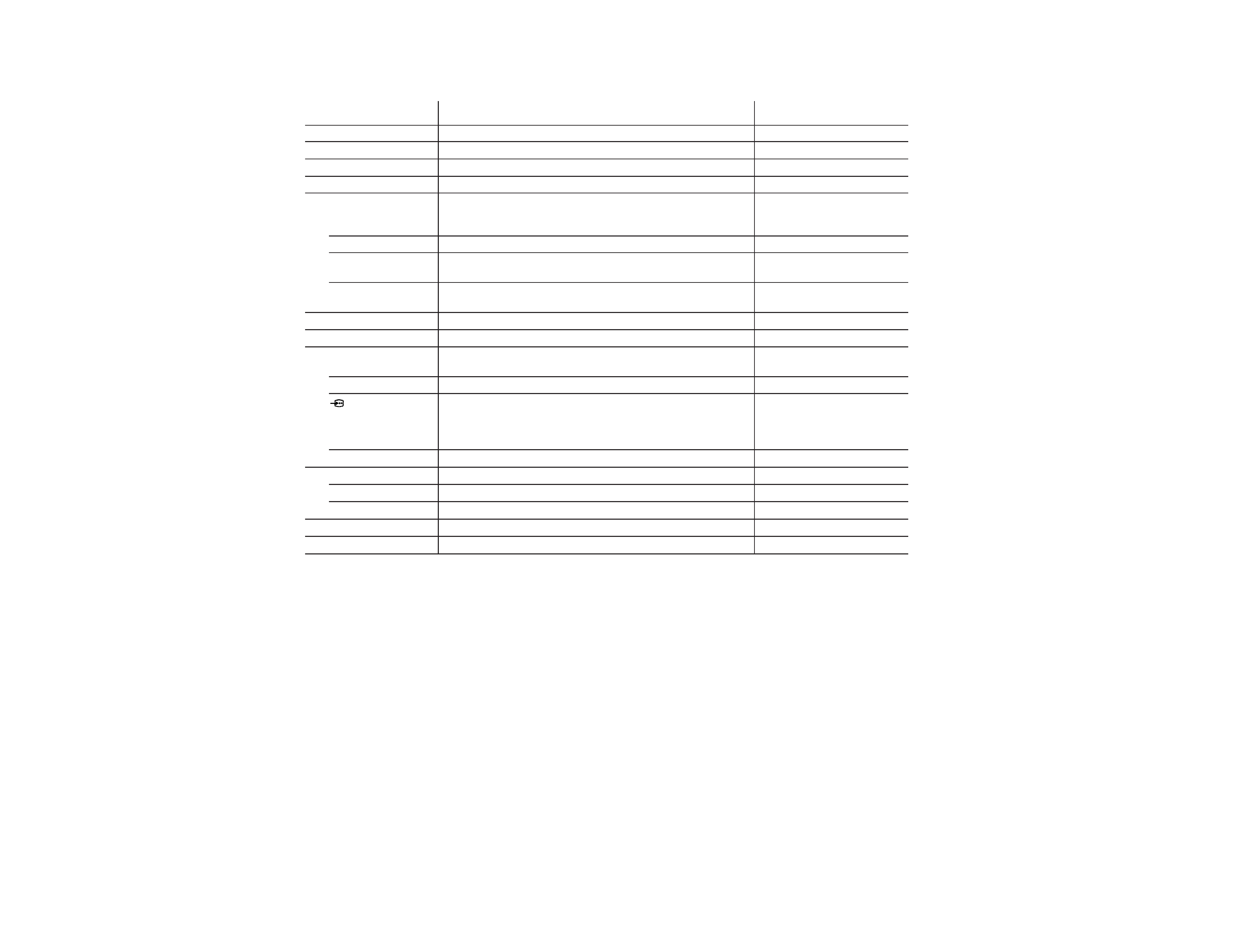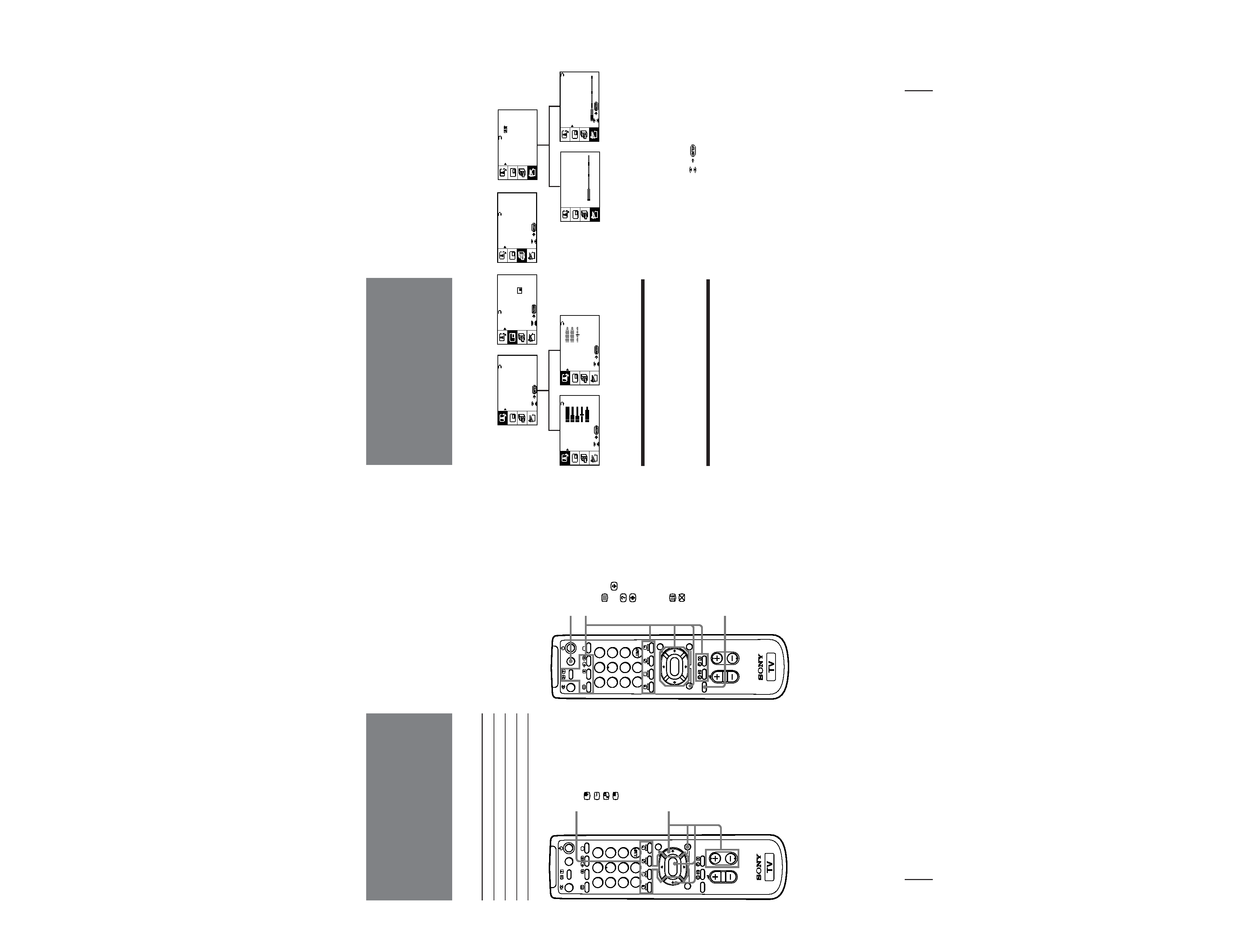
MODEL
COMMANDER DEST. CHASSIS NO.
KV-LX34M50
RM-871
IndonesiaSCC-K67D-A
MODEL
COMMANDER DEST. CHASSIS NO.
CHASSIS
TRINITRON ® COLOR TV
SERVICE MANUAL
BG-1L

2
KV-LX34M50
RM-871
SPECIFICATIONS
Note
Power requirements
110-240 V AC, 50/60 Hz
Power consumption (W) Indicated on the rear of TV
Television system
B/G, I, D/K, M
Color system
PAL, PAL 60, SECAM, NTSC4.43, NTSC3.58
Channel coverage
B/G
VHF: E2 to E12 / UHF: E21 to E69 /
CATV: S01 to S03, S1 to S41
I
UHF: B21 to B68 / CATV: S01 to S03, S1 to S41
D/K
VHF: C1 to C12, R1 to R12 / UHF: C13 to C57, R21 to R60
CATV: Z1 to Z39, S01 to S03, S1 to S41
M
VHF: A2 to A13 / UHF: A14 to A79 /
CATV: A-8 to A-2, A to W+4, W+6 to W+84
Antenna
75-ohm external terminal
Audio output (speaker)
5W + 5W + 15W (3D WOOFER)
Number of terminal
D (Video)
Input: 4 Output: 1
Phono jacks; 1 VP-P, 75 ohms
(Audio)
Input: 4 Output: 1
Phono jacks; 500 mVrms
(S Video)
Input: 2
Y : 1 Vp-p, 75 ohms,
unbalanced, sync
negative
C : 0.286 Vp-p, 75 ohms
2
(Headphone)
Output: 1
Minijack
Picture tube
34 in.
Tube size (cm)
86
Measured diagonally
Screen size (cm)
80
Measured diagonally
Dimension (w/h/d, mm)
950
× 662 × 593
Mass (kg)
77
SAFETY-RELATED COMPONENT WARNING!!
COMPONENTS IDENTIFIED BY SHADING AND MARK
! ON
THE SCHEMATIC DIAGRAMS, EXPLODED VIEWS AND IN THE
PARTS LIST ARE CRITICAL TO SAFE OPERATION. REPLACE
THESE COMPONENTS WITH SONY PARTS WHOSE PART
NUMBERS APPEAR AS SHOWN IN THIS MANUAL OR IN
SUPPLEMENTS PUBLISHED BY SONY.
CAUTION
SHORT CIRCUIT THE ANODE OF THE PICTURE TUBE AND
THE ANODE CAP TO THE METAL CHASSIS, CRT SHIELD, OR
CARBON PAINTED ON THE CRT, AFTER REMOVING THE
ANODE.
Design and specifications are subject to change without notice.

3
KV-LX34M50
RM-871
TABLE OF CONTENTS
Section
Title
Page
1. GENERAL ........................................................... 4
2. DISASSEMBLY
2-1.
3D Speaker Box Removal ....................................... 15
2-2.
Rear Cover Removal ............................................... 15
2-3.
Speaker Removal ..................................................... 15
2-4.
Chassis Assy Removal ............................................. 15
2-5.
Service Position ....................................................... 16
2-6.
P1 Board Removal ................................................... 16
2-7.
P2 and S1 Boards Removal ..................................... 16
2-8.
B3 and DF Boards Removal .................................... 17
2-9.
A and D Boards Removal ........................................ 17
2-10. F1, H5 and K Boards Removal ............................... 17
2-11.
DGC Removal .......................................................... 17
2-12. Switch Block Removal ............................................ 18
2-13. Picture Tube Removal ............................................. 18
3. SELF DIAGNOSIS FUNCTION ......................... 20
4. SET-UP ADJUSTMENTS
4-1.
Beam Landing .......................................................... 21
4-2.
Convergence ............................................................ 22
4-3.
Focus Adjustment .................................................... 24
4-4.
G2 (Screen) and White Balance Adjustments ......... 24
5. CIRCUIT ADJUSTMENT
5-1.
Adjustments with Commander ................................ 26
5-2.
Adjustment Method ................................................. 27
5-3.
Picture Quality Adjustments .................................... 32
5-4.
Display Position Adjustment ................................... 32
5-5.
A Board Adjustment After IC003 (Memory)
Replacement ............................................................. 33
5-6.
Picture Distortion Adjustment ................................. 33
Section
Title
Page
6. DIAGRAMS
6-1.
Block Diagram ......................................................... 35
6-2.
Frame Schematic Diagram ...................................... 37
6-3
Circuit Boards Location .......................................... 40
6-4.
Schematic Diagrams and Printed Wiring Boards ... 40
(1)
Schematic Diagrams of D, F1, H5 and H6 Boards . 45
(2)
Schematic Diagram of A Board ............................... 49
(3)
Schematic Diagrams of B3, P1, P2
and VM Boards ........................................................ 57
(4)
Schematic Diagrams of C1, DF, K and S1
Boards ...................................................................... 61
6-5.
Semiconductors ........................................................ 67
7. EXPLODED VIEWS
7-1.
Picture Tube ............................................................. 69
7-2.
Chassis ..................................................................... 70
7-3.
3D Speaker ............................................................... 71
8. ELECTRICAL PARTS LIST ............................... 72

4
KV
-LX34M50
RM-871
SECTION 1
GENERAL
The operating instructions mentioned here are partial abstracts from the
Operating Instr uctions Manual. The page numbers of the Operating
Instruction Manual remain as in this manual.
Getting Started
7
12
3
L (MONO)
R
3
(MONO)
When connecting a monaural VCR
Connect the yellow plug to
D(VIDEO) and the black plug to -L (AUDIO-L MONO).
When connecting video game equipment
Connect video game equipment to the ... 3 (VIDEO 3 INPUT) jacks at the front of your TV or the ... (VIDEO IN) 3 jacks at the rear of
your TV.
When connecting a VCR to the
(antenna) terminal
Preset the signal output from the VCR to the program position 0.
When connecting video equipment to the ... 3 (VIDEO 3 INPUT) jacks or the ... (VIDEO IN) 3 jacks
Do not connect video equipment to the ... 3 (VIDEO 3 INPUT) jacks at the front and the ... (VIDEO IN) 3 jacks at the rear of your TV
simultaneously; otherwise the picture will not be displayed properly on the screen.
If both S Video and video signals are input simultaneously
The S Video input signal is selected. To view a video input signal, disconnect the
(S Video) connection.
Note on the video input
When no signal is input, the screen becomes blue.
Connecting audio/video equipment using Ú (MONITOR/TV OUT) jacks
Front of TV
Camcorder
to S video output
to video and
audio outputs
: Signal flow
Rear of TV
VCR
to
antenna
output
to video and
audio inputs
D(yellow)
-L (white)
-R (red)
Audio system
to audio
inputs
: Signal flow
to
antenna
socket
or
Getting Started
6
12
3
L (MONO)
R
Connecting a VHF antenna or a combination VHF/UHF antenna
-- 75-ohm coaxial cable (round)
Attach an optional IEC antenna connector to the 75-ohm coaxial cable.
Plug the connector into the
(antenna) socket at the rear of the TV.
Connecting optional equipment
You can connect optional audio/video equipment to your TV such as a VCR, multi disc player, camcorder, video
game or stereo system.
Connecting video equipment using video input jacks
Connections
On a wall
Rear of TV
Rear of TV
or
Rear of TV
(yellow)
-L (white)
-R (red)
VCR
to
S Video
output
to
antenna
output
to video and
audio outputs
: Signal flow
Getting Started
to
antenna
socket
to
S Video
input

5
KV
-LX34M50
RM-871
Getting Started
8
Names of buttons on the remote commander are indicated in different colors to represent the available functions.
Label color
Button function
White
For general TV operations.
Green
For Teletext operations. (This is not used for this model)
Yellow
For PIP and PROGRAM INDEX operations.
PROGR
MENU
PIP PROGR
GAME
PROGR
INDEX
PIP
TEXT
1
2
3
4
5
6
7
8
0
-/--
9
POWER
BASSO
ENTER
A/B
Getting to know the
remote commander
PIP operation buttons
(page 22)
(page 23)
(page 23)
(page 22)
V/v/ENTER
for PIP PROGR (page 22)
PROGRAM INDEX
operation buttons
PROGR INDEX (page 21)
V/b/v/B/ENTER (page 21)
PROGR +/ (page 21)
GAME (page 27)
Teletext operation buttons
(This is not used for this model)
(page 24, 25)
A/B
(page 25)
(page 25)
(page 24)
[ ]
Red (page 24)
[ ]
Green (page 24)
[ ]
Yellow (page 24)
[ ]
Blue (page 24)
(page 24)
(page 25)
PIP TEXT (page 26)
V/b/v/B/ ENTER (page 26)
POWER BASSO (page 18)
PROGR
MENU
PIP PROGR
GAME
PROGR
INDEX
PIP
TEXT
1
2
3
4
5
6
7
8
0
-/--
9
POWER
BASSO
ENTER
A/B
Getting Started
9
Introducing the
menus
You can preset TV channels, adjust the picture and sound qualities, and select some settings using the on-screen
menus. You can use the buttons on both the remote commander and the TV to operate the menus.
A/V CONTROL
PIP
FEATURES
Getting back to the previous menu
(except for AUTO PROGRAM)
Press V or v to move the cursor (z) to the first
line (N) of each menu, and press ENTER.
Cancelling the menu screen
Press MENU.
Notes (except for AUTO PROGRAM)
· When a menu is selected after pressing ENTER, the color of
both the menu and the menu symbol change and the cursor
(z) appears beside the first item of the menu.
· When an item on the menu is selected after pressing ENTER,
the color of the item changes.
· You can refer to the guide (
) at the bottom of the
menus (except for the PRESET menu) for the basic operations
of the menu.
· If more than approximately 60 seconds elapse after you press a
button, the menu screen disappears automatically.
PI P
P IP:
OF F
P IP TE X T
STROB E
POS I T I ON:
PROGR
I ND EX
PRESET
BASS
80
00
80
TREBLE
BALANCE
A UD I O AD J UST
PRES E T
S KIP:
PR0 2 OFF
TV S Y S :
B / G
COL SYS : AUTO
ENGL I SH
AUTO PROGRAM
MANUA L PROGRAM
L A NGUAGE /
:
P I C T URE
40
100
0
80
V I DEO AD J UST
COL OR
BR I GHT
HUE
SHARP
VM :
HIGH
45
0
TV S Y S :
B / G
AUTO PROGRAM
VHF L O W
PR : 0 1
TV S Y S :
B / G
VHF LO W
PR : 0 1
AT T :
OFF
MANUA L PROGRAM
GAME MODE
HYPER S URROUND :
OF F
MONITOR
AV OUT :
F E AT URES
A / V CONT ROL
DY NAMIC
SOF T
S T A NDARD
P ERSONAL
V I DEO AD J UST
A UD I O AD J UST
*
( This is not used for this model)
*
